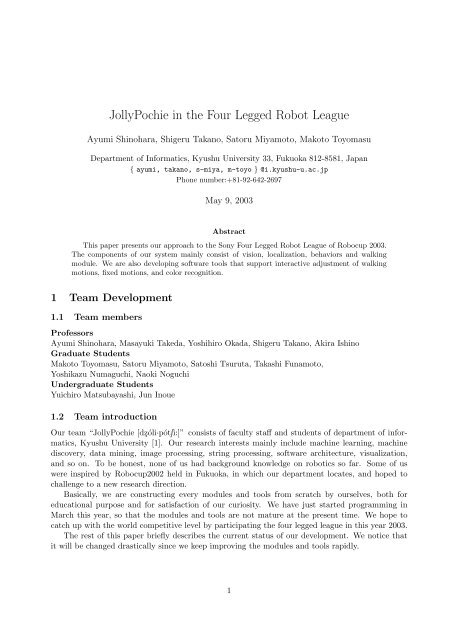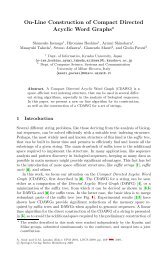JollyPochie in the Four Legged Robot League
JollyPochie in the Four Legged Robot League
JollyPochie in the Four Legged Robot League
You also want an ePaper? Increase the reach of your titles
YUMPU automatically turns print PDFs into web optimized ePapers that Google loves.
<strong>JollyPochie</strong> <strong>in</strong> <strong>the</strong> <strong>Four</strong> <strong>Legged</strong> <strong>Robot</strong> <strong>League</strong>Ayumi Sh<strong>in</strong>ohara, Shigeru Takano, Satoru Miyamoto, Makoto ToyomasuDepartment of Informatics, Kyushu University 33, Fukuoka 812-8581, Japan{ ayumi, takano, s-miya, m-toyo } @i.kyushu-u.ac.jpPhone number:+81-92-642-2697May 9, 2003AbstractThis paper presents our approach to <strong>the</strong> Sony <strong>Four</strong> <strong>Legged</strong> <strong>Robot</strong> <strong>League</strong> of Robocup 2003.The components of our system ma<strong>in</strong>ly consist of vision, localization, behaviors and walk<strong>in</strong>gmodule. We are also develop<strong>in</strong>g software tools that support <strong>in</strong>teractive adjustment of walk<strong>in</strong>gmotions, fixed motions, and color recognition.1 Team Development1.1 Team membersProfessorsAyumi Sh<strong>in</strong>ohara, Masayuki Takeda, Yoshihiro Okada, Shigeru Takano, Akira Ish<strong>in</strong>oGraduate StudentsMakoto Toyomasu, Satoru Miyamoto, Satoshi Tsuruta, Takashi Funamoto,Yoshikazu Numaguchi, Naoki NoguchiUndergraduate StudentsYuichiro Matsubayashi, Jun Inoue1.2 Team <strong>in</strong>troductionOur team “<strong>JollyPochie</strong> [d¸zóli·pót ∫ i:]” consists of faculty staff and students of department of <strong>in</strong>formatics,Kyushu University [1]. Our research <strong>in</strong>terests ma<strong>in</strong>ly <strong>in</strong>clude mach<strong>in</strong>e learn<strong>in</strong>g, mach<strong>in</strong>ediscovery, data m<strong>in</strong><strong>in</strong>g, image process<strong>in</strong>g, str<strong>in</strong>g process<strong>in</strong>g, software architecture, visualization,and so on. To be honest, none of us had background knowledge on robotics so far. Some of uswere <strong>in</strong>spired by Robocup2002 held <strong>in</strong> Fukuoka, <strong>in</strong> which our department locates, and hoped tochallenge to a new research direction.Basically, we are construct<strong>in</strong>g every modules and tools from scratch by ourselves, both foreducational purpose and for satisfaction of our curiosity. We have just started programm<strong>in</strong>g <strong>in</strong>March this year, so that <strong>the</strong> modules and tools are not mature at <strong>the</strong> present time. We hope tocatch up with <strong>the</strong> world competitive level by participat<strong>in</strong>g <strong>the</strong> four legged league <strong>in</strong> this year 2003.The rest of this paper briefly describes <strong>the</strong> current status of our development. We notice thatit will be changed drastically s<strong>in</strong>ce we keep improv<strong>in</strong>g <strong>the</strong> modules and tools rapidly.1
Figure 1: Screen Shot of Color Classification ToolFigure 2: Example of Classified Images2 VisionGenerally an autonomous robot does not have very fast CPU <strong>in</strong>side him/her, we thought that itis costly and possibly obstructs real-time operation to process large or high color images. Thuswe adopted CDTs (Color Detection Table) which can handle up to eight colors at frame rate foridentify objects on court, because <strong>the</strong> robot has <strong>the</strong> color detection facility <strong>in</strong> hardware. By us<strong>in</strong>g<strong>the</strong> CDTs of seven colors, we can detect <strong>the</strong> field objects such as goal, marker, enemy or friendrobot and ball. Concretely, <strong>the</strong> seven colors <strong>in</strong> <strong>the</strong> court are orange for <strong>the</strong> ball, blue and yellow for<strong>the</strong> goals, p<strong>in</strong>k, green, blue, yellow for <strong>the</strong> landmarks (blue and yellow are <strong>the</strong> same colors as goals),dark red and dark blue for <strong>the</strong> robots. The exact range of each color must be determ<strong>in</strong>ed to classify<strong>the</strong>se seven colors. Our color classification tool (Fig. 1) is very simple, but useful for adjust<strong>in</strong>g <strong>the</strong>CDTs. Figure 2 illustrates <strong>the</strong> example of color classified images obta<strong>in</strong>ed by our developed tool.Additionally, dur<strong>in</strong>g <strong>the</strong> ball track<strong>in</strong>g, <strong>the</strong> distance from <strong>the</strong> robot to <strong>the</strong> ball is computed byus<strong>in</strong>g <strong>the</strong> <strong>in</strong>frared sensor. This <strong>in</strong>formation is useful to determ<strong>in</strong>e <strong>the</strong> next action of <strong>the</strong> robot.3 LocalizationAt <strong>the</strong> moment, <strong>the</strong> localization task does not work as we expected. In order to determ<strong>in</strong>e <strong>the</strong> nextaction of a robot, it is necessary to know <strong>the</strong> location of <strong>the</strong> robot itself and which goal to attack ordefend. Each robot is programmed to protect its own defense area. However s<strong>in</strong>ce our localization2
module was not good enough, we could not give full play to its effect. It is extremely importantfor a goalkeeper robot to keep <strong>the</strong> defense area. Therefore, regard<strong>in</strong>g <strong>the</strong> goalkeeper, we <strong>in</strong>troducedonly goal as <strong>the</strong> exact landmark and could obta<strong>in</strong> good localization <strong>in</strong>formation.4 BehaviorsWe have developed a quite powerful shoot<strong>in</strong>g action “PowerBomb Shoot”, named after a similaraction <strong>in</strong> professional wrest<strong>in</strong>g. After lift<strong>in</strong>g up <strong>the</strong> boll by front legs, <strong>the</strong> robot fl<strong>in</strong>gs it aga<strong>in</strong>st<strong>the</strong> floor and simultaneously hits it by <strong>the</strong> front face. It is so powerful that even <strong>the</strong> goalkeepercan aim to shoot to <strong>the</strong> opponent goal directly if it has a chance. We carefully designed that <strong>the</strong>motion completes shorter than three seconds.We have two attackers which also served as defenders. The basic behavior of attackers is, (1)f<strong>in</strong>d <strong>the</strong> ball, (2) approach <strong>the</strong> ball if it could f<strong>in</strong>d it, (3) turn around <strong>the</strong> ball toward <strong>the</strong> opponentgoal, without touch<strong>in</strong>g <strong>the</strong> ball <strong>in</strong> order to prevent hold<strong>in</strong>g, and (4) perform <strong>the</strong> PowerBomb shoot.At every position, it try to shoot whenever it is possible. We locate each attacker as “Left W<strong>in</strong>g”and “Right W<strong>in</strong>g” area.The defender would do clear kick <strong>in</strong>stead of PowerBomb Shoot based on <strong>the</strong> situation. Thegoalkeeper does as follows. (1) try to f<strong>in</strong>d <strong>the</strong> ball, (2) traverse near to <strong>the</strong> ball, (3) clear <strong>the</strong> ballif it is close to goal.5 MotionIt is important for <strong>the</strong> robot to search <strong>the</strong> ball, goals, and polls even <strong>in</strong> <strong>the</strong> process of mov<strong>in</strong>gforward, backward, or turn<strong>in</strong>g. It requires that <strong>the</strong> head can be moved <strong>in</strong>dependently from <strong>the</strong>action of legs. On <strong>the</strong> o<strong>the</strong>r hand, fixed motions such as kick<strong>in</strong>g, shoot<strong>in</strong>g, and gett<strong>in</strong>g up requirecooperative action between <strong>the</strong> head and legs. By this reason, we classified basic motions <strong>in</strong>to twocategories. One is for fixed motions which requires cooperative head movement, and <strong>the</strong> o<strong>the</strong>r isfor walk<strong>in</strong>g motions which does not require it. Based on this idea, we have developed two softwaretools which support exploit<strong>in</strong>g new motions and walk<strong>in</strong>g styles respectively, through <strong>the</strong> graphicaluser <strong>in</strong>terface.The movement is controlled by two modules Head and Walker. The Head modules controls <strong>the</strong>tilt, pan and roll of <strong>the</strong> neck for search<strong>in</strong>g landmarks, while <strong>the</strong> Walker modules controls both neckand legs. When perform<strong>in</strong>g a fixed action, <strong>the</strong> Head falls <strong>in</strong>to <strong>the</strong> idle state and <strong>the</strong> Walker modulescontrols everyth<strong>in</strong>g. By this classification, we can simply specify <strong>the</strong> behaviors without confliction.It contributed our rapid development, although a subtle control was ra<strong>the</strong>r difficult.5.1 Walk<strong>in</strong>g motion development toolThe walk<strong>in</strong>g motion development tool help us to adjust<strong>in</strong>g parameters which affect walk<strong>in</strong>g motions<strong>in</strong>teractively (Fig. 3). The parameters consist of <strong>the</strong> positions at which each leg reaches <strong>the</strong> floorand leave from it, <strong>the</strong> height of <strong>the</strong> head position, <strong>the</strong> height of <strong>the</strong> hip position, phase difference αbetween <strong>the</strong> left and right legs, phase difference φ between <strong>the</strong> front left leg and <strong>the</strong> right rear leg,<strong>the</strong> power ratio β of one stroke, <strong>the</strong> shape of <strong>the</strong> stroke, and <strong>the</strong> period of one stroke. From <strong>the</strong>separameters, we compute all angles of <strong>the</strong> jo<strong>in</strong>ts <strong>in</strong> four legs by <strong>in</strong>verse k<strong>in</strong>ematics. We can transmit<strong>the</strong> parameters to <strong>the</strong> robot via TCP connection, and observe its behavior <strong>in</strong>teractively.3
Figure 3: Walk<strong>in</strong>g motion develop<strong>in</strong>g toolFigure 4: Fixed motion develop<strong>in</strong>g tool5.2 Fixed motion develop<strong>in</strong>g toolIn our system, a fixed motion is specified by a sequence of 15 tuples of angles. Three angles areused for tilt, pan and role of <strong>the</strong> neck, <strong>the</strong> rests are for legs (three angles for each leg). We canedit every values both <strong>in</strong> degree and micro-radian by choos<strong>in</strong>g one of two sheets (Fig. 4). We cantransmit <strong>the</strong>se values to <strong>the</strong> robot via TCP connection, and observe its behavior <strong>in</strong>teractively. Wedeveloped <strong>the</strong> PowerBomb Shoot by us<strong>in</strong>g this tool.6 Conclud<strong>in</strong>g remarksWe have expla<strong>in</strong>ed <strong>the</strong> current state of our development very briefly. As o<strong>the</strong>r teams always do, weare cont<strong>in</strong>u<strong>in</strong>g <strong>the</strong> development and improv<strong>in</strong>g <strong>the</strong> modules and tools day by day. Therefore it isquite natural that our programs will be changed drastically.References[1] <strong>JollyPochie</strong> Homepage 4



